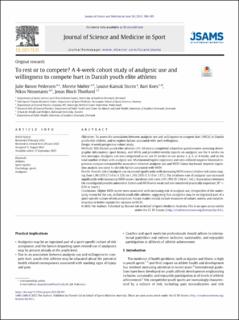| dc.contributor.author | Pedersen, Julie Rønne | |
| dc.contributor.author | Møller, Merete | |
| dc.contributor.author | Storm, Louise Kamuk | |
| dc.contributor.author | Koes, Bart | |
| dc.contributor.author | Ntoumanis, Nikos | |
| dc.contributor.author | Thorlund, Jonas Bloch | |
| dc.date.accessioned | 2024-01-05T08:28:50Z | |
| dc.date.available | 2024-01-05T08:28:50Z | |
| dc.date.created | 2023-10-05T10:54:38Z | |
| dc.date.issued | 2023 | |
| dc.identifier.citation | Journal of Science and Medicine in Sport. 2023, 26(11), Side 580-585. | en_US |
| dc.identifier.issn | 1440-2440 | |
| dc.identifier.uri | https://hdl.handle.net/11250/3110013 | |
| dc.description | This is an open access article under the CC BY license (http://creativecommons.org/ licenses/by/4.0/). | en_US |
| dc.description.abstract | Objectives: To assess the association between analgesic use and willingness to compete hurt (WCH) in Danish youth elite athletes, and to explore factors associated with such willingness.
Design: 4-week prospective cohort study.
Methods: 592 Danish youth elite athletes (15–20 years) completed a baseline questionnaire assessing demographic information, sport history, and WCH, and provided weekly reports on analgesic use for 4 weeks via text messages. Analgesic use was categorized as no use (0 weeks) or use across 1, 2, 3, or 4 weeks, and as the total number of days with analgesic use. Multinomial logistic regression and zero-inflated negative binomial regression analyses estimated the association between analgesic use and WCH. Linear backward stepwise regression analysis was used to identify factors associated with WCH.
Results: Overall, risk of analgesic use increased significantly with increasing WCH scores (relative risk ratios ranging from 1.06 (95% CI 1.0 to 1.12%) to 1.34% (95% CI 1.15 to 1.57)). The incidence rate of analgesic use increased significantly with increasing WCH scores (incidence rate ratio 1.09 (95% CI 1.04 to 1.14)). Associations between the investigated possible antecedent factors and WCH were weak and not considered practically important (R2 = 0.05 or lower).
Conclusions: Higher WCH scores were associated with increasing risk of analgesic use, irrespective of the underlying reason for the use, in Danish youth elite athletes, suggesting that analgesics may be an ingrained part of a sport-specific culture of risk acceptance. Future studies should include measures of culture, norms, and social interaction to better explain the variance in WCH. | en_US |
| dc.language.iso | eng | en_US |
| dc.subject | analgesics | en_US |
| dc.subject | athletes | en_US |
| dc.subject | psychology | en_US |
| dc.subject | sport injuries | en_US |
| dc.subject | sports | en_US |
| dc.subject | sports psychology | en_US |
| dc.title | To rest or to compete?: A 4-week cohort study of analgesic use and willingness to compete hurt in Danish youth elite athletes | en_US |
| dc.type | Peer reviewed | en_US |
| dc.type | Journal article | en_US |
| dc.description.version | publishedVersion | en_US |
| dc.rights.holder | © 2023 The Authors | en_US |
| dc.source.pagenumber | 580-585 | en_US |
| dc.source.volume | 26 | en_US |
| dc.source.journal | Journal of Science and Medicine in Sport | en_US |
| dc.source.issue | 11 | en_US |
| dc.identifier.doi | 10.1016/j.jsams.2023.08.181 | |
| dc.identifier.cristin | 2181953 | |
| dc.description.localcode | Institutt for idrettsmedisinske fag / Department of Sports Medicine | en_US |
| cristin.ispublished | true | |
| cristin.fulltext | original | |
| cristin.qualitycode | 1 | |
